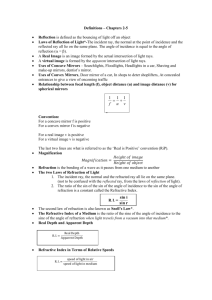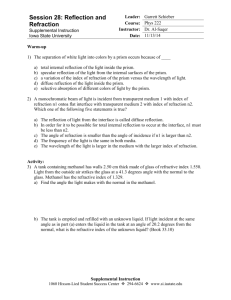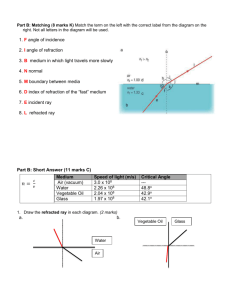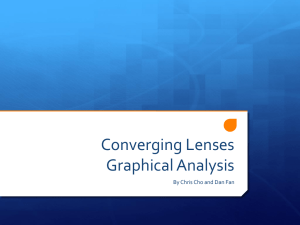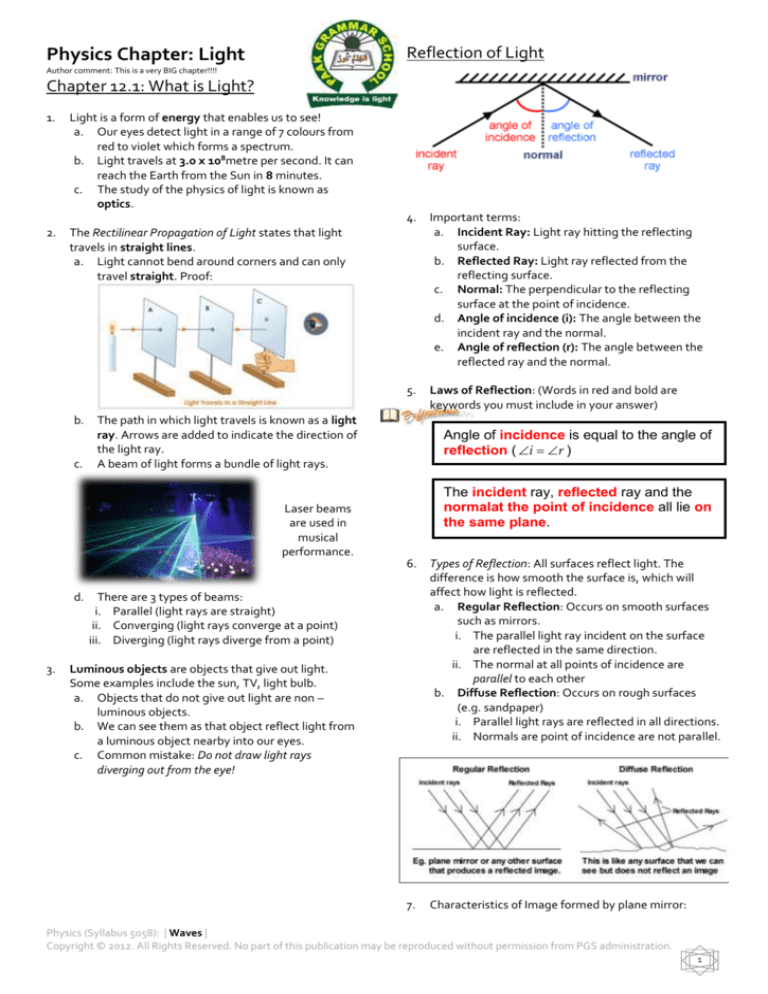
Reflection of Light
Physics Chapter: Light
Author comment: This is a very BIG chapter!!!!
Chapter 12.1: What is Light?
1.
2.
Light is a form of energy that enables us to see!
a. Our eyes detect light in a range of 7 colours from
red to violet which forms a spectrum.
b. Light travels at 3.0 x 108metre per second. It can
reach the Earth from the Sun in 8 minutes.
c. The study of the physics of light is known as
optics.
Important terms:
a. Incident Ray: Light ray hitting the reflecting
surface.
b. Reflected Ray: Light ray reflected from the
reflecting surface.
c. Normal: The perpendicular to the reflecting
surface at the point of incidence.
d. Angle of incidence (i): The angle between the
incident ray and the normal.
e. Angle of reflection (r): The angle between the
reflected ray and the normal.
5.
Laws of Reflection: (Words in red and bold are
keywords you must include in your answer)
The Rectilinear Propagation of Light states that light
travels in straight lines.
a. Light cannot bend around corners and can only
travel straight. Proof:
b.
c.
The path in which light travels is known as a light
ray. Arrows are added to indicate the direction of
the light ray.
A beam of light forms a bundle of light rays.
Laser beams
are used in
musical
performance.
d.
3.
4.
Angle of incidence is equal to the angle of
reflection ( i r )
The incident ray, reflected ray and the
normalat the point of incidence all lie on
the same plane.
6.
Types of Reflection: All surfaces reflect light. The
difference is how smooth the surface is, which will
affect how light is reflected.
a. Regular Reflection: Occurs on smooth surfaces
such as mirrors.
i. The parallel light ray incident on the surface
are reflected in the same direction.
ii. The normal at all points of incidence are
parallel to each other
b. Diffuse Reflection: Occurs on rough surfaces
(e.g. sandpaper)
i. Parallel light rays are reflected in all directions.
ii. Normals are point of incidence are not parallel.
7.
Characteristics of Image formed by plane mirror:
There are 3 types of beams:
i. Parallel (light rays are straight)
ii. Converging (light rays converge at a point)
iii. Diverging (light rays diverge from a point)
Luminous objects are objects that give out light.
Some examples include the sun, TV, light bulb.
a. Objects that do not give out light are non –
luminous objects.
b. We can see them as that object reflect light from
a luminous object nearby into our eyes.
c. Common mistake: Do not draw light rays
diverging out from the eye!
Physics (Syllabus 5058): | Waves |
Copyright © 2012. All Rights Reserved. No part of this publication may be reproduced without permission from PGS administration.
1
a.
b.
c.
d.
e.
8.
Same Size
Laterally Inverted
Upright
Virtual
Distance from image from mirror = Distance of
object from mirror.
Applications of Mirrors:
a. Optical Testing (Mirrors can make letters appear
further away, saving space)
b. Blind Corners (for drivers)
c. Periscopes
Refraction at Plane Surfaces
9.
The bending effect of light as it passes from one
transparent material to another is known as
refraction.
a. Refraction is caused by the change in speed of
light.
b. At the boundary of 2 optical media, if there is a
sudden change in the speed of light, it will cause
the path of light to bend.
c. Light travels fastest in air/vaccum.
10. Laws of Refraction: (Words in red and bold are
keywords you must include in your answer)
Snell’s Law: The ratio of the sine of the
angle of incidence to the sine of the angle
sin i
of refraction is constant. (
constant )
sin r
Water
Air
e.
f.
1.33
1.00
Note the position of the numerator and
denominator. The denser medium is the bottom,
air is always at the top. Snell’s law cannot be used
if neither media is air/vaccum.
Light can be both reflected and refracted at the
boundary of 2 optical medium (to be explored
later)
12. When light travels from a less dense medium to a
denser medium, the ray of light moves towards the
normal.
a. Likewise, when light travels from a denser to a
less dense medium, the ray of light moves away
from the normal.
b. When light enter a medium perpendicularly,
regardless of its density, no deviation of the ray is
observed.
13. The Principle of Reversibility of Light states that light
will follow exactly the same path if its direction of
travel is reversed.
a.
Therefore,
sin r 1
sin i n
14. Phenomena/applications of refraction:
a. Swimming pool appears shallower than it really
is. To find refractive index,
Real depth
n
Apparent depth
Total Internal Reflection
The incident ray, refracted ray and the
normalat the point of incidence all lieon
the same plane.
11. The refractive index of a medium is a ratio between
the speed of light in air and the speed of light in a
medium.
Speed of light in air
n
Speed of light in medium
sin i
b. Since the constant
constant , we can
sin r
sin i
say:
refractive index
sin r
a.
c.
d.
Therefore,
The greater the value of refractive index of a
medium, the greater the bending of light, and the
more denser the material is.
Some common refractive indexes (useful to
ensure your answer is not too far off):
Medium
Diamond
Glass
Refractive Index,
2.40
1.48 – 1.96
15. Total Internal Reflection occurs when light travels
from an optically denser medium to a less dense
medium.
16. Critical Angle is the angle of incidence in the optically
denser medium where the angle of refraction in the
less dense medium = 90o.
17. 3 important cases of light reflection/refraction.
a. When angle of incidence <
Critical Angle: Normal
Refraction
b. There is still a faint
reflected ray back into the
glass.
a.
b.
When angle of incidence =
Critical Angle: Travels
perpendicular to the
surface (90°)
As i is made bigger,
the refracted ray
gets closer and closer to
Physics (Syllabus 5058): | Waves |
Copyright © 2012. All Rights Reserved. No part of this publication may be reproduced without permission from PGS administration.
2
c.
the surface of the glass.
Can be found by taking
c.
LCD Projector
1
c sin 1
n
a.
b.
c.
When angle of incidence >
Critical Angle: Total
Internal Reflection.
No light is being refracted
through the glass-to-air
boundary.
Light is totally reflected
back into the glass block.
18. Applications of total internal reflection:
a. Glass prisms
b. Optical fibres: Made up of plastic fibres that
transmit light over long distances through total
internal reflection.
i. An optical fibre has a core of high refractive
index, coated with another material of lower
refractive index.
ii. Light rays entering the fibre will be internally
reflected at the boundary between these 2
refractive materials.
23. Some examples:
Action of a thin converging lens on a parallel beam of light
parallel to the principal axis.
Thin Converging Lens
19. A lens is a clear plastic or glass with curved surfaces.
They are used in magnifying glasses, projectors, etc.
a. There are 2 types of lenses: Converging and
diverging lens.
20. Main features of a converging lens (just briefly know
this terms will do):
a. Optical Centre (C): The midway point between the
lens surface on the principal axis
b. Principal axis: The line passing symmetrically
through the optical centre of the lens
c. Principal focus (F): Point on the principal axis
where rays of light converge after passing
through the lens
d. Focal length (f): Distance between the optical
centre, C and the principal focus F.
e. Focal plane: Plane which passes through F and P.
It is perpendicular to principal axis.
21. There are 3 definite paths of light travelling through a
thin converging lens. Using 2 of these paths, we can
find the position of an image formed by a lens.
----------------------------------------------------------------------------c. An image is real and inverted if it is behind the lens,
else it is virtual and upright.
22. Applications of converging lenses
a. Magnifying glass: It is a thin converging lens that
can be used to make objects look bigger.
b. Camera
Action of a thin converging lens on a parallel beam of light
NOT parallel to the principal axis.
Ray Diagrams for Lenses
Step 1: Setting up the ray diagram.
a. Principle Axis: Draw a horizontal line to represent the
principal axis.
b. Lens: Draw a line perpendicular to the horizontal line
with arrowheads.
c. Focal Point: Mark a point F on the principle axis on
both sides. The length of each F from the optical
centre should be equal.
Step 2: Placing the object
a. Object: Place the object on the left of the lens by
marking it with an upright arrow.
Step 3: Tracing the light rays and drawing the image
a. Select 2 of the 3 definite paths. Usually the first 2 paths
are selected.
b. The point where the 2 paths intersect on the right side
of the lens is the position of the image.
c. Draw a downward arrow from the principle axis to the
intersection point, and mark it as I. (This denotes that
the image is inverted)
Step 4: Reading the ray diagram
a. An image is inverted if it is below the principle axis.
Physics (Syllabus 5058): | Waves |
Copyright © 2012. All Rights Reserved. No part of this publication may be reproduced without permission from PGS administration.
3
b.
An image is diminished if the distance from it to the
optical centre is lesser than the distance of the object
from the optical centre.
Physics (Syllabus 5058): | Waves |
Copyright © 2012. All Rights Reserved. No part of this publication may be reproduced without permission from PGS administration.
4

